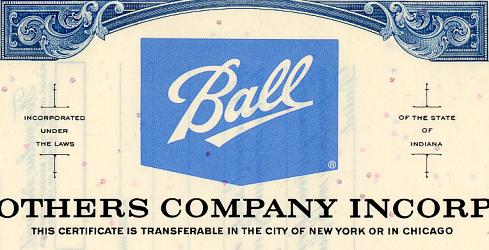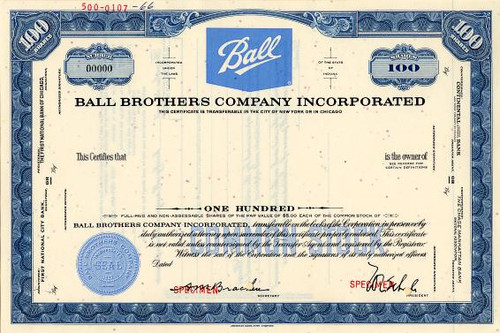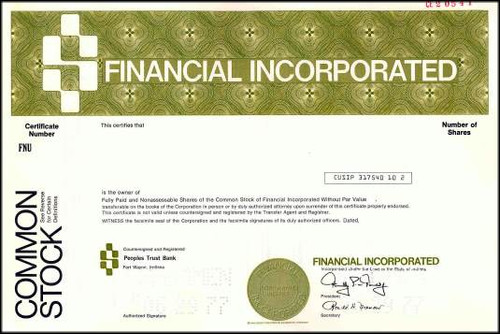Beautifully engraved specimen certificate from Ball Brothers Company Incorporated printed in 1966. This historic document was printed by American Bank Note Company and has an ornate border around it with a vignette of the company's logo. This item has the signatures of the Company's President and Secretary and is over 40 years old. 
Certificate Vignette Ball Corporation Founded: 1880 (Buffalo, New York); 1887 (Muncie) Location: Meridian Street, Muncie (Indiana factory, 18881970s); Meriweather Avenue near Blaine; Macedonia Avenue and Ninth Street (later 1509 South Macedonia Avenue); 345 South High Street (corporate headquarters, 197698) In 1880 Frank and Edmund Ball established the Wooden Jacket Can Company in Buffalo, New York. With a two-hundred dollar loan from their uncle, the Ball brothers purchased some tin, wooden jackets, a set of hand tinner's tools, and patent rights to certain can designs from A. W. Aldrich, a local manufacturer of copper tea kettles. Aldrich was happy to sell his unprofitable wood-jacketed oilcan division to the young men. The Balls soon developed a better and cheaper method of applying the wooden jackets to the tin cans, and Frank obtained orders from throughout the Midwest. A fire destroyed the brothers' first factory, but they reestablished themselves at a new location on Main Street. In 1883 Frank and Edmund's three brothers--George, William, and Lucius--joined the business. As the popularity of tin oilcans declined, the brothers began to manufacture glass oil containers. By 1885 they were producing their own glass, and in February 1886 they incorporated as the Ball Brothers Glass Manufacturing Company, with Frank as president. In 1884 or 1885 Ball Brothers began manufacturing the threaded-top glass jars for home canning first designed by John Mason; Mason jars became an important basis of the company's prosperity. In 1886 fire destroyed the Ball Brothers glass manufacturing plant in Buffalo. At the same time the discovery of midwestern natural gas fields launched a boom in western Ohio and eastern Indiana. As the brothers considered building a new plant, they were courted by midwestern civic leaders ready to offer land, gas, and moving expenses to companies willing to locate factories in their communities. The Muncie natural gas boom began in 1886, and its business leaders, led by James Boyce, raised $120,000 to attract factories to the city. In the summer of 1887 they offered the Ball Brothers company $5,000, free land, free gas, and a private rail link connecting the factory to Muncie's main rail line. The brothers accepted the offer and opened their plant on Meridian Street in March 1888. By 189495 the workforce at the glass manufacturing plant grew to 1000 men who were producing 22 million fruit jars for home canning. The company grew through technological innovation and aggressive expansion. In 1898 Ball Brothers perfected an automatic glass jar machine, the only practical machine for manufacturing widemouth jars and bottles. A 1910 Indianapolis newspaper article claimed that the Muncie plant, which covered 35 acres and produced 90 million jars in one year, was making half of the world's supply. The firm vertically integrated, not only producing a wide variety of glass jars but also acquiring factories to produce straw paper and corrugated cardboard for packing the jars, zinc mills to produce materials for the screw caps, and rubber plants in order to manufacture rubber sealing rings. Ball Brothers acquired fourteen glass companies between 1898 and 1936. As the company expanded and acquired plants throughout the United States, the Ball family came to dominate Muncie society. The brothers built elegant homes on a strip of land along the White River, which they called Minnetrista Boulevard, and became major benefactors of the city. They backed the city's hospital and donated the campus and buildings that became Ball State University. The Ball family was, as sociologists Robert and Helen Lynd noted critically in Middletown in Transition, almost synonymous with Muncie. The Ball Brothers Glass Manufacturing Company prospered, becoming the Ball Brothers Company in 1922. Between the 1930s and early 1950s, however, it faced a series of crises that resulted in its restructuring. Sales of the company's fruit jars dropped by half between 1931 and 1932 and the precipitous fall in profits caused the company to slash the prices of its fruit jars. The effects of the Great Depression also prodded the company to expand, and after the end of Prohibition in 1933 the Ball Brothers Company began producing alcoholic beverage bottles. The company's participation in industrywide patenting agreements for glass-producing machinery made it a party to an antitrust suit launched by the Franklin D. Roosevelt administration in 1939. In that year Ball Brothers was manufacturing almost 55 percent of all the fruit jars in the country. The case of United States v. Hartford-Empire et al. was finally ended in 1947 when the United States Supreme Court disallowed the industry's patenting system and enjoined the Ball Brothers Company from any further expansion in the glassware industry. The period from 1946 through 1954 marked, a significant change in the Ball company and in the Ball family generational leadership. Frank Ball, the founder and president for sixty-three years, died in 1943. The company was in crisis--it faced the demands of a newly unionized labor force, it lacked controls on production, costs, personnel, inventory, and sales, and its organization and planning were inadequate. In addition, production capacity had outstripped marketing, and production costs were eating into profits, forcing the cash-strapped company to negotiate a vital $1 million loan from the John Hancock Life Insurance Company of Boston in 1948. In response to these challenges, the company brought in outside managers, altered its profile, and diversified, expanding, for example, into the plastics and aerospace industry. In 1955 it established a research and development department. Gradually, the privately owned firm loosened its attachment to Muncie and the glass-jar business that had been the foundation of its prosperity. Due to declining profits, Ball Brothers Company closed its Muncie plant, much to the shock of the local community and 600 displaced workers. It did, however, retain its corporate headquarters in the city, opening a new office building in 1976. In 1969 the company became the Ball Corporation and in 1972 went public. Over the years the company had expanded into the production of metal and plastic containers and zinc products. By the 1990s it produced most of the copper-coated zinc penny blanks used by the U.S. Mint. Metal beverage cans became its leading product by the 1980s. In 1992 the corporation produced 14 billion aluminum and steel beverage cans and 33 billion metal food containers for the United States and Canadian markets and was expanding into Pacific Rim markets, including Japan and China. Ball Corporation's wholly owned subsidiary Ball-InCon Glass Packaging Corporation was North America's third-largest supplier of commercial glass containers. In 1993 Ball Corporation spun off seven of its divisions, including its metal cans, zinc products, and plastics divisions, into the Alltrista Corporation, an independent company based in Muncie. By the mid-1990s the company boasted annual sales of $2.3 billion and employed more than 14,000 workers in 22 states. In February 1998 Ball Corporation announced that it would move its headquarters from Muncie to Broomfield, Colorado. Two years before the announcement Ball Corporation had sold its interest in Ball-Foster Glass Container Corporation and had closed its metal food container plant in Columbus, leaving the company without any manufacturing sites in Indiana. The move to Colorado was intended to reduce travel costs and improve communications within the company. Alltrista and Ball-Foster continued to produce the items traditionally made by Ball Corporation and remained in Muncie. In 1999 R. David Hoover became Ball Corporation's president, succeeding George A. Matsik. Hoover had been the chief financial officer for the firm and an employee since 1970. Hoover and Leon Midgett, the company's new chief operating officer, had overseen the $746 million acquisition of the North American manufacturing assets of the Reynolds Metals Company in 1998, making Ball the largest manufacturer of aluminum beverage cans in North America. In 1999 the Ball Corporation stood as a $2.9 billion company with over 12,600 employees. George A. Sissel retained the post of chairman of the board. History from Wikipeida and OldCompanyResearch.com.
About Specimens Specimen Certificates are actual certificates that have never been issued. They were usually kept by the printers in their permanent archives as their only example of a particular certificate. Sometimes you will see a hand stamp on the certificate that says "Do not remove from file". Specimens were also used to show prospective clients different types of certificate designs that were available. Specimen certificates are usually much scarcer than issued certificates. In fact, many times they are the only way to get a certificate for a particular company because the issued certificates were redeemed and destroyed. In a few instances, Specimen certificates we made for a company but were never used because a different design was chosen by the company. These certificates are normally stamped "Specimen" or they have small holes spelling the word specimen. Most of the time they don't have a serial number, or they have a serial number of 00000. This is an exciting sector of the hobby that grown in popularity over the past several years.

Certificate Vignette
About Specimens Specimen Certificates are actual certificates that have never been issued. They were usually kept by the printers in their permanent archives as their only example of a particular certificate. Sometimes you will see a hand stamp on the certificate that says "Do not remove from file". Specimens were also used to show prospective clients different types of certificate designs that were available. Specimen certificates are usually much scarcer than issued certificates. In fact, many times they are the only way to get a certificate for a particular company because the issued certificates were redeemed and destroyed. In a few instances, Specimen certificates we made for a company but were never used because a different design was chosen by the company. These certificates are normally stamped "Specimen" or they have small holes spelling the word specimen. Most of the time they don't have a serial number, or they have a serial number of 00000. This is an exciting sector of the hobby that grown in popularity over the past several years.








